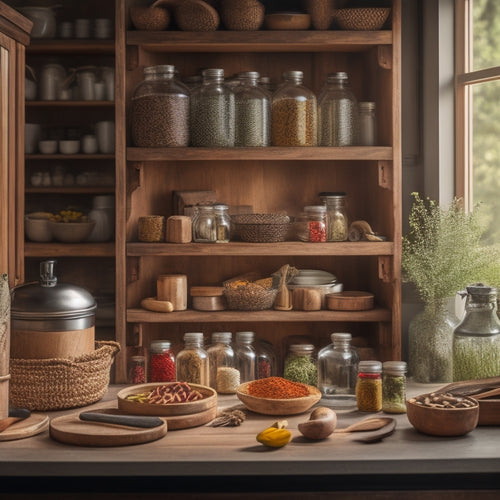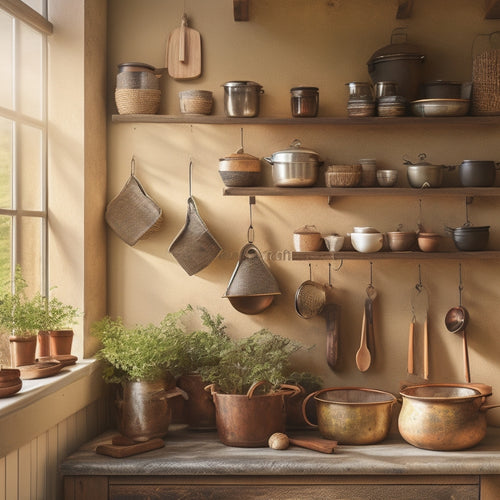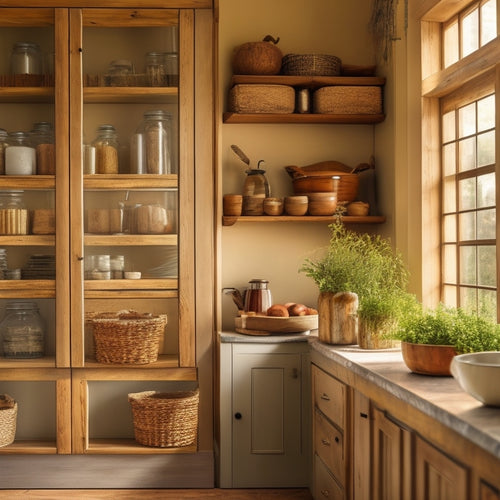
Decanting Food: To Store or Not to Store
Share
I've thoughtfully considered the benefits and drawbacks of decanting food, and I'm convinced that the key to making it worthwhile lies in striking a balance between the two. On one hand, decanting can revolutionize pantry organization, enhance meal planning, and reduce food waste. On the other hand, it can be time-consuming and costly. To make decanting work for me, I prioritize frequently used items, choose the right containers, and label each one. By tailoring my approach to my unique needs and preferences, I can create a sustainable and personalized decanting habit that enhances my daily life - and there's more to discover about how to make it truly effective.
Key Takeaways
• Decanting food can enhance meal planning, reduce food waste, and save time and money, but it requires a significant time investment.
• Prioritize frequently used items with high turnover rates, like baking ingredients and spices, to maximize decanting benefits.
• Choose the right containers, such as airtight OXO Pop containers, and label them to maintain organization and avoid mixing up items.
• Balance the benefits of decanting with the drawbacks, considering personal preferences for storage solutions and unique needs.
• Tailor your decanting approach to your lifestyle, experimenting with different items and tools to create a sustainable and personalized system.
The Benefits of Decanting
Decanting my food items into clear containers has revolutionized my pantry organization. It allows me to easily see what I have on hand and makes meal planning a breeze. This simple step has saved me time and reduced stress in the kitchen.
With a clear view of my ingredients, I can plan meals around what I already have, reducing food waste and saving money. While some may view decanting as a time investment, I've found it's worth the cost analysis - the benefits far outweigh the effort. Plus, it aligns with my personal preferences for a tidy and organized space.
The Drawbacks of Decanting
I've recently come to realize that the time I spend transferring food items into containers is taking away from other important tasks, like meal prep and cooking. Decanting, as beneficial as it is, requires a significant time investment.
Acquiring containers can also be costly, which affects cost effectiveness. Constantly transferring items to matching containers can be time-consuming, taking away from more pressing tasks.
As I weigh the pros and cons, I'm learning to balance my desire for a streamlined pantry with the need for efficient time management. It's crucial to evaluate whether decanting is worth the extra effort and expense.
Choosing the Right Items
What types of food items are most suitable for decanting, and how can we determine which ones will benefit from this process?
As I consider decanting, I prioritize items that are frequently used, have a high turnover rate, or are prone to clutter. Baking ingredients like flour and sugar are top contenders, as are pasta and decanting spices for aesthetic appeal.
Individual serving snacks are also ideal for decanting, making them easy to grab and go. When organizing snacks, I choose items that are often consumed together, like nuts or dried fruits.
The Decanting Process
Five necessary steps are involved in the decanting process, which, when followed, can help secure a smooth and efficient shift to a well-organized pantry. I start by creating a list of items to be decanted and their required storage space, making sure I choose the right containers for each item.
Airtight containers like OXO Pop containers are excellent for decanting, as they maintain freshness and keep contents visible. I label each container to avoid mixing up items, and utilize additional tools like scoops for easy access. By following these steps, I can achieve decanting efficiency and enjoy a clutter-free pantry.
Container selection is essential, as it determines the overall success of the decanting process. By selecting the right containers, I can secure a safe and organized storage space that meets my needs.
Making Decanting Work for You
To make decanting a sustainable and personalized habit, it's important to tailor your approach to your unique needs, preferences, and lifestyle.
I've found that considering my personal preferences is key to making decanting work for me. For instance, I prioritize storage solutions that are both functional and aesthetically pleasing. By choosing containers that fit my style, I'm more likely to maintain my decanting routine.
I also experiment with different types of items to decant, finding what works best for my household. By balancing my needs and preferences, I've created a decanting system that saves me time and reduces clutter.
With a little creativity and flexibility, decanting can become a habit that enhances my daily life.
Frequently Asked Questions
How Often Should I Clean and Sanitize My Decanting Containers?
Just as a garden requires regular watering, my decanting containers need frequent cleaning and sanitizing to prevent contamination; I aim to sanitize them every 1-2 weeks, using a gentle yet effective solution and materials like stainless steel or glass.
Can I Decant Expired or Near-Expired Food Items?
I avoid decanting expired or near-expired food items, prioritizing food safety and health concerns, as expired food can spoil quickly, causing health issues, and instead, I follow proper storage guidelines to maintain freshness.
Are Glass Containers Better Than Plastic for Decanting Food?
As I weigh my options, I wonder: are glass containers better than plastic for decanting food? I consider the environmental impact, durability, and health concerns, ultimately opting for glass for its eco-friendly, non-toxic, and aesthetically pleasing benefits.
How Do I Prevent Moisture Buildup in Decanted Food Containers?
To prevent moisture buildup in decanted food containers, I guarantee proper ventilation, use dehumidifiers, and add silica packets to absorb excess moisture, while maintaining airtight seals to keep moisture out and freshness in.
Can I Decant Food Items in Small, Irregularly-Shaped Containers?
"I'm surprised 75% of households waste food due to poor storage. When it comes to decanting in small, irregularly-shaped containers, I find creative solutions like using baskets or mason jars for space-saving options, while maintaining aesthetic appeal and presentation impact."
Related Posts
-

Revolving Cabinet Organizer Lazy Susan
A revolving cabinet organizer like a Lazy Susan is a transformative solution for your kitchen. It maximizes space and...
-

Wall-Mounted Racks for Kitchen Tool Storage
Wall-mounted racks are perfect for maximizing storage in your kitchen. By utilizing vertical space, you can free up u...
-

Freestanding Pantry Units for Farmhouse Kitchen Style
Freestanding pantry units perfectly blend beauty and function in your farmhouse kitchen. They maximize storage while ...


